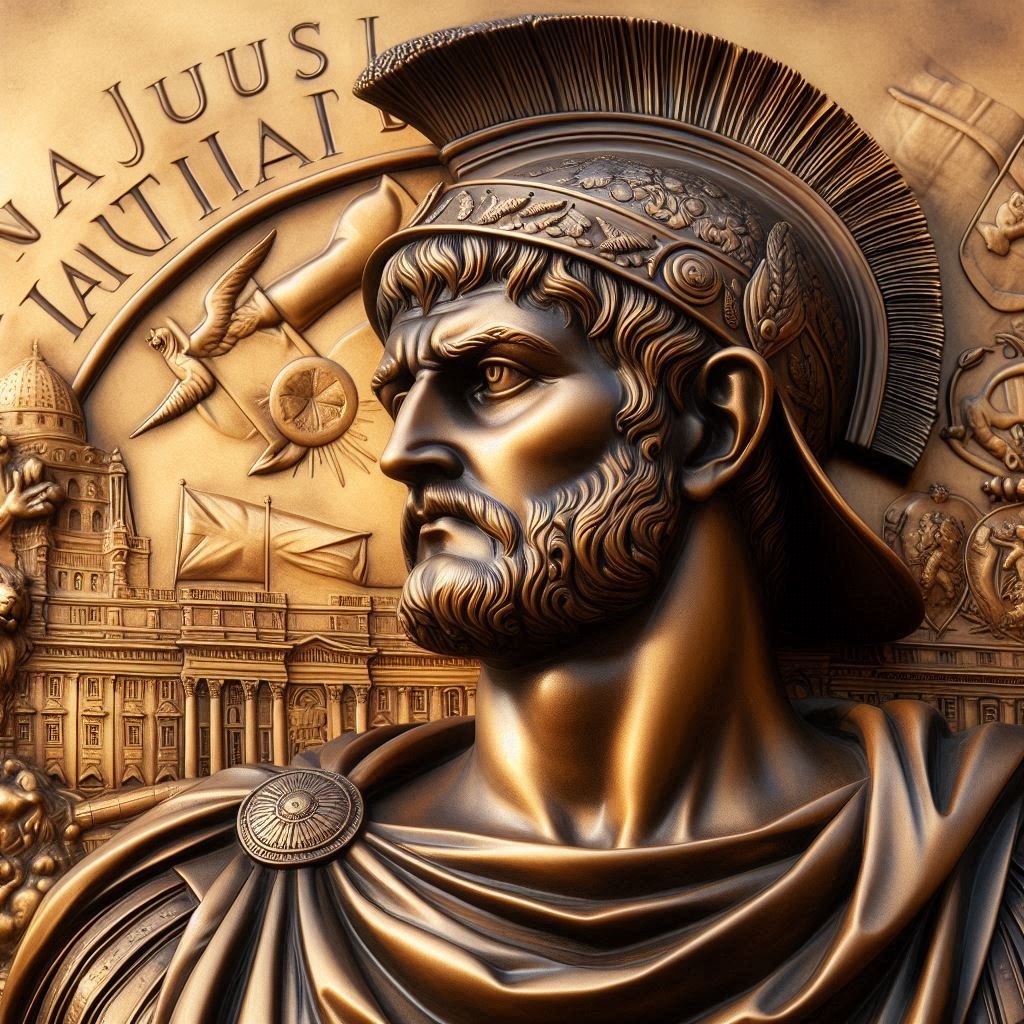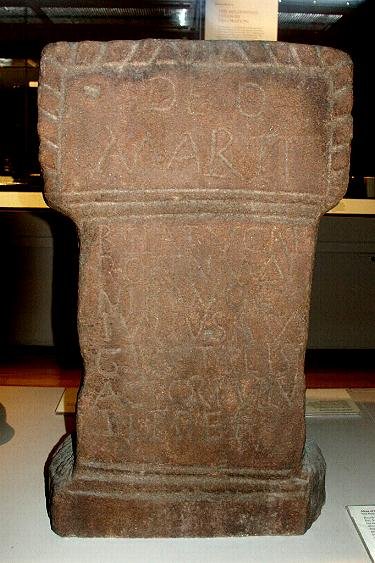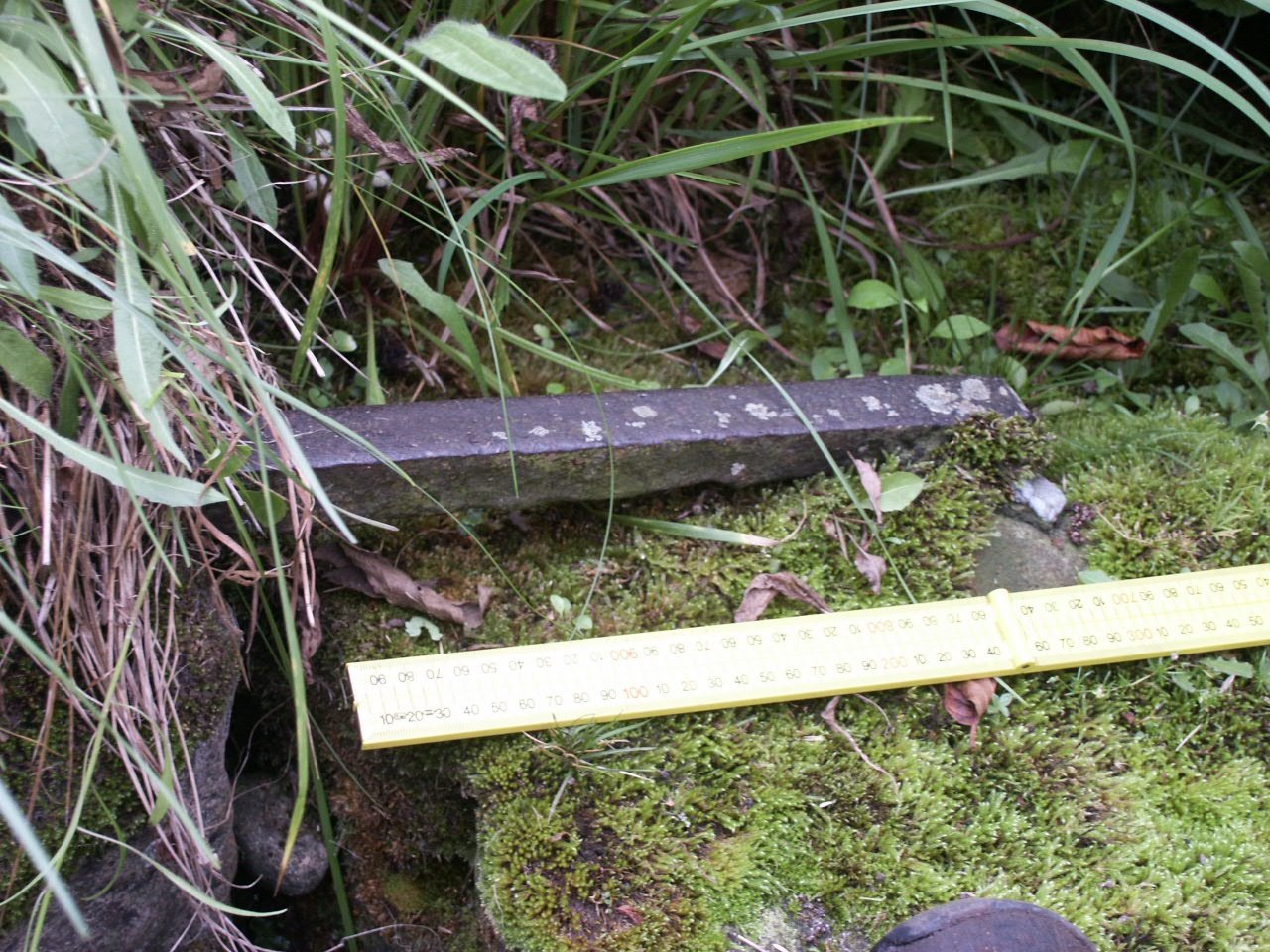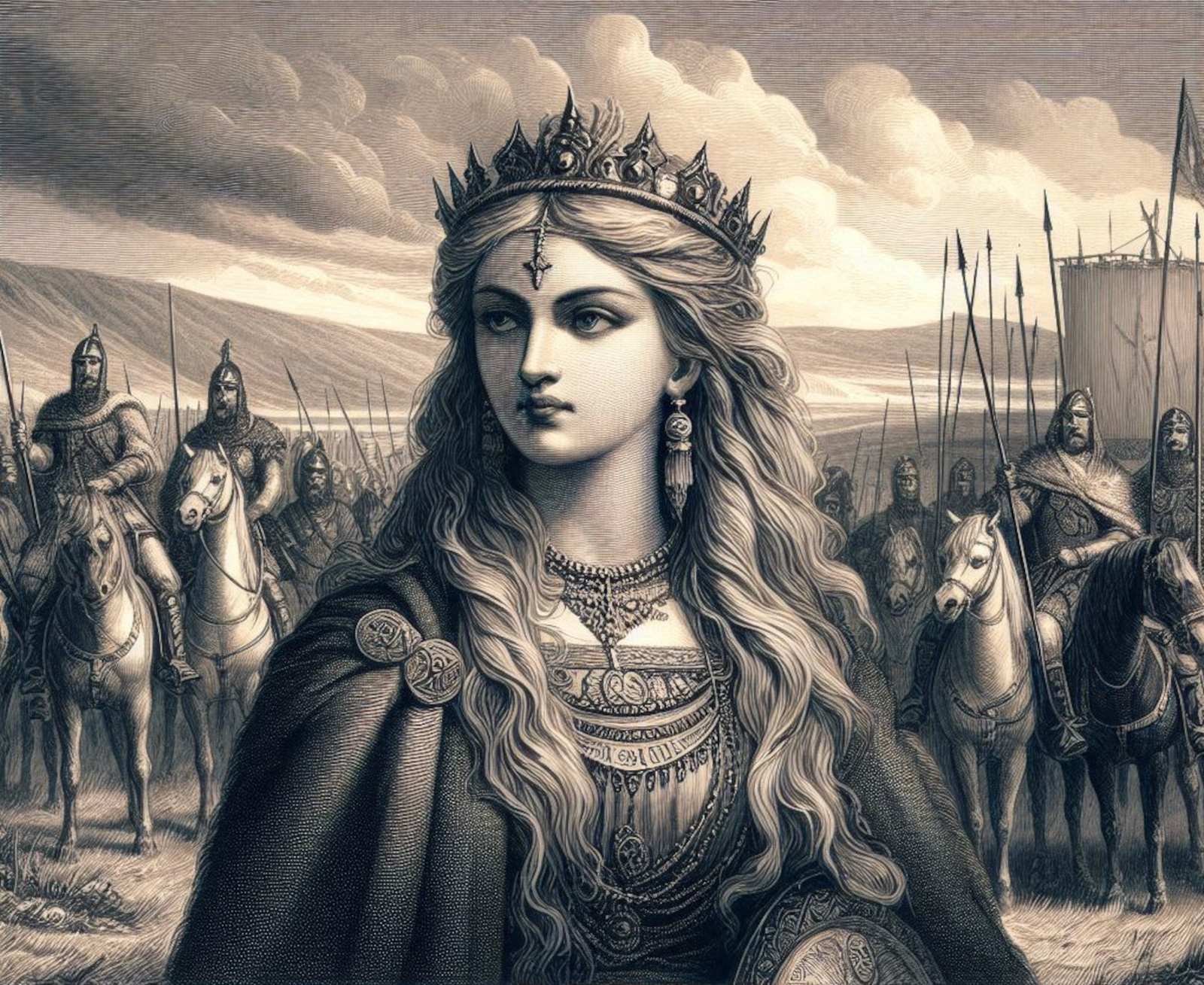Brigantia, Cartimandua and Gwenhwyfar
by
Michelle Ziegler,
Belleville, Illinois
The name Brigantia represents three separate concepts: a goddess, a people, and a tribal federation. By the Roman period, the name represented a tribal federation compromising all of what would become the Roman province of Britannia Secunda, except for the Parisi territory, east of the River Derwent. According to Ptolemy, Brigantian territory stretched from sea to sea, making its people the most numerous in Britain (Higham 1987:9). Initially, the entire Brigantian federation entered into the empire as a single civitas, whose capital was at Isurium Brigantium, modern Aldborough.
During the post-Roman period, the province of Britannia Secunda reverted to a state more reminiscent of its pre-Roman tribal society. The civitas of the Parisi quickly became the kingdom of Deira (Dumville 1989). Rheged appears to have been formed from the civitas of the Carvetii (Dark 1994:71-72). The Civitas Brigantium became divided into the regions or kingdoms of Elmet, Craven, and perhaps Brigantia, located on an axis from York to Catterick, plus probably others whose names have not survived. Aldborough/Isurium Brigantia was occupied in the fifth century but the civitas capital of the Brigantes would likely have been relocated to Eboracum (York; Dark 1994:72-74).
The term Brigantia and the concept of the goddess Brigantia survived into the post-Roman period. John Koch has tentatively translated two stanzas of the poem Y Gododdin to read “as [?] Brigantia rose, ascending towards the sky” (A.58) and “the man who [?]went down into [?] Brigantia was slain on a spear shaft” (A.71) (Koch 1997:107, 113). Catterick, the site of the main action in Y Gododdin, was deep in pre-Roman Brigantian territory.
All of the known post-Roman northern leaders located within the former territory of the Brigantian federation are found within the dynasty of Coel Hen the Protector.4 This creation of this super-dynasty may indicate that regions as far separate as Rheged in Cumbria and Elmet in south-eastern Brigantia were linked together in some sort of political union. This union could have taken several forms, from an actual federation with a supreme king to an alliance of tribes with a dominant king or alternatively, a succession of dominant kings exerting hegemony over the other kingdoms of the former province of Britannia Secunda. If the dynasty of Coel Hen can be seen to have been used by later scribes as a justification or rationalization for the reformation of the Brigantia polity, the localization of the Coeling dynasts suggests Brigantian territory extended beyond its limits under the Romans to include the Gododdin and part of Galloway.
Although fourth century Roman forts were abandoned all over Britain, Kenneth Dark observed “that out of at most 16 sites with later 5th-6th century evidence no fewer than 14 had probably been under the command of the Dux Britanniarum at the end of the 4th century” (Dark 1998). Not only were these sites reoccupied, they were refortified and Saxon mercenaries may have been recruited to man them, as mentioned in the Historia Brittonum (Dark 1992). The high status of these sites is illustrated by the British halls found in Birdoswald fortress (Dark 1992) and the fifth century Christian church found in the fortress of Vindolanda (Wilkinson 1998). Further occupation has been found at the two towns closest to the Wall, Carlisle and Corbridge, plus the other Brigantian towns of Catterick, Aldborough, York and Malton (Dark 1992). Placenames and Welsh tradition further specifically associate the Coelings with the Mote of Liddel, Papcastle (Derventio), and Catterick (Miller 1975). All of these sites are believed to be located within pre-Roman Brigantian territory.
In the fifth and sixth centuries, which have been called the Age of Arthur, the tribes of Greater Brigantia were indeed on their way to becoming a major power again. The combination of extensive fortification of the abandoned Roman sites and a dynasty that includes rulers located throughout the former Brigantian territory suggests that either the federation actually or functionally became reformed by alliance and/or hegemony. With the rebirth of Greater Brigantian independence, the pre-Roman past would have been recalled with pride and sorrow.
The Fall of Brigantia
When the Romans arrived in the first century, they found the vast Brigantian tribal federation in the neck of Britain organized under Queen Cartimandua (c. 43 to c. 70 AD), whose seat was at the massive fortification of Stanwick. Cartimandua’s husband was acknowledged as king, assuming the role as the Brigantian warlord. The Roman historian Tacitus (Annals 12.40, 2-7; Histories 3.45; Koch 1995:39-40) specifically acknowledges that it was Cartimandua, the living symbol of Brigantia, who held the ultimate power among the Brigantes and had an active role in choosing her husband/warlord. Indeed, it has been suggested that the Welsh word for king, brenin, is derived from brigantinos meaning the consort of Brigantia (Koch 1995:39). The Romans must have been pleased when they found that Cartimandua favored establishing formal contacts and alliances with them. Although firm evidence is lacking, it is believed that Brigantia became a Roman client kingdom as early as the 40’s AD (Hanson and Campbell 1986:73).
Initially, Brigantia prospered as a client state and grew wealthy. In 51 AD, Caratacus son of Cunobelinus, the leader of Celtic resistance to the Romans in the south, was captured and brought before Cartimandua, who promptly turned him over to the Romans. Tacitus (3.45; Koch 1995:40) credited Cartimandua’s capture of Caratacus as “having secured the most important component of Emperor Claudius’s triumph”.
In c. 69 AD, Cartimandua divorced her husband Venutius and took as her husband another warrior named Vellocatus (“better in battle”), Venutius’s former armor bearer. However this was no simple divorce for, by this action, her new husband became king. Tacitus (3.45; Koch 1995:39-40) recorded that the divorce and remarriage prompted a civil war among the Brigantes because the majority of the people preferred Venutius as king. Yet, Cartimandua’s will prevailed, “favoring the illegitimate husband [Vellocatus] were the queen’s libido and her ferocious temper” (Tacitus 3.45; Koch 1995:40).
Venutius, who had previously fought for the Romans, turned to the anti-Roman faction among the Brigantes for support and ignited a civil war. The war continued for some time among the Brigantes until Venutius was on the eve of victory. With Cartimandua in a compromised position, the Romans intervened to save their ally (Salway 1993:92). Roman intervention saved Cartimandua but in the end her actions gave the Romans an excuse to conquer Brigantia. The Romans could not tolerate the long Brigantian border in the hands of a hostile king who could not only attack the south himself but also harbor Roman enemies from the south (Salway 1993:92). To the Brigantians, the fault for their conquest by the Romans would have fallen squarely on the shoulders of Cartimandua and the war between her husbands . . . and would not have been forgotten.
Cartimandua was capable of such behavior because she was a living representative of the goddess of sovereignty, Brigantia (Koch 1995:39-40; Ross 1996:354-355). According to Anne Ross, “Cartimandua’s powerful role in Roman times may suggest that society recognized the power of the goddess by mirroring her authority in its own temporal ruler. . . . This particular goddess may have been as much concerned with the actual tribal hegemony as with the territory” (Ross 1996:456). According to Patrick Ford, horses were intimately associated with goddesses of sovereignty (Ford 1977: 8-10). It is possible that Cartimandua inherited this role since her name literally means “sleek pony” (Ross 1996:449).
Brigantia was a goddess who manifested herself under three forms. If we can take her later manifestation in Ireland as a guide, Cormac’s Glossary tells us Brigantia represented first and foremost sovereignty, with her other two aspects representing healing and metal working (Byrne 1973; Ross 1996:456). Anne Ross further identifies Brigantia as a patroness of pastoral peoples in Ireland and Britain. The advent of Christianity did not abolish the role of Brigantia as a symbol of sovereignty. According to John Koch, “a further survival of this idea is seen in the fragmentary elegy to the 7th century Welsh king Cadwallon in which the River Braint (<*Briganti) is described as overflowing in grief for its fallen consort”.
Cartimandua and Gwenhwyfar
The similarity between the activity of Cartimandua and the fate of Brigantia in the first century with Arthur’s Queen Gwenhwyfar (Guinevere) and the fall of Arthur’s realm in Geoffrey’s History of the Kings of Britain is striking. The case of Cartimandua takes a mythical possibility for the activities of the personification of Brigantia into the realm of historical fact. Like Cartimandua, Gwenhwyfar is said to have replaced her husband Arthur with his trusted commander Medraut (Modred). According to Geoffrey of Monmouth, Medraut (Modred) recruited foreign troops from the Saxons; similarly, Cartimandua recruited help from the Romans. The result in both cases is a ferocious civil war that leads to the destruction of the kingdom and eventual domination by an outside force. Both parties also recruited foreigners; the Romans in the first century and the Angles in the fifth- to seventh-centuries in the north. Exactly ten years after Arthur’s death at Camlann in the Annales Cambriae, Ida founds Anglian Bernicia, the original Anglian kingdom that grew into Northumbria. However, Arthur’s fall may not originally have been considered a key event in the Anglian domination of Britain.16 In both cases, the queen herself survives unharmed; Gwenhwyfar fled to a convent and Cartimandua was rescued by her Romans allies.
Both Gwenhwyfar and Cartimandua would have sought refuge in the current capital of Brigantia in the eras in which the two stories are set. Cartimandua is likely to have fortified herself at Stanwick, the pre-Roman Brigantian capital. We might imagine that Cartimandua fell back on her religious role for protection. According to Geoffrey, Gwenhwyfar and Medraut were living together in York when Arthur arrived to challenge them. From York, Gwenhwyfar flees to the church of Julius the Martyr. Geoffrey located this church in Caerleon but, in an article within this issue, P.J.C. Field identifies York as the original site of the Church of Julius the Martyr. To Peter Korrel, Gwenhwyfar’s flight to a convent is an indication that she had been a willing partner of Medraut (Korrel 1984:121-122). Gwenhwyfar is not a victim seeking reunification with her first husband but Medraut’s accomplice.
Nothing is known about the final battle between Venutius and Vellocatus or the Romans, so it cannot be compared with Camlann other than for the likelihood that both battles occurred within Brigantian territory. The leading contender for the site of Camlann is Camboglanna on Hadrian’s Wall and, also therefore, within the former Brigantian territory. After the Roman rescue of Cartimandua, Venutius is not heard from again and the Roman conquest of Brigantia begins.
We know that the tales of Gwenhwyfar and Medraut existed prior to the writing of Geoffrey’s History: Indeed the entire adultery scenario set out by Geoffrey of Monmouth seems to have been common knowledge. Geoffrey (Thorpe 1966: 257-258) “prefers to say nothing” of it. Furthermore, Geoffrey tells us his version of Camlann and, probably, the affair of Gwenhwyfar came from “the British treatise already referred to” that he claims was also known by Walter of Oxford (Thorpe 1966:258). This could all be chalked up to Geoffrey covering his tracks, except that the evidence of the Modena Archivolt stands as testimony to the existence of the association of Gwenhwyfar and Medraut prior to Geoffrey’s writing. Modern dates for the archivolt are c. 1120-1140 (Lacy 1996:325), which is contemporary with Geoffrey of Monmouth. The scene depicted on the archivolt is obscure and probably does not represent any one tale currently known. It shows Medraut (Mardoc) and Gwenhwyfar (Winlogee) in a wooden fortress being besieged by Arthur (Artus de Bretania) and some of his knights, including Gawain (Galvagin), but excluding Lancelot (Lacy 1996:325).
Although approximately 400 years separates Cartimandua’s fate and the traditional date of Gwenhwyfar’s origin, John Koch has argued that Roman conquest era history survived in Brittonic oral history fairly intact through the medieval period. Peter Korrel also sees Welsh sources such as the Historia Brittonum and the Welsh oral tales as the basis for Geoffrey’s Arthur. He believes that the Arthurian romances owe little or nothing to Geoffrey (Korrel 1984:116-117).
Gwenhwyfar has other similarities with Brigantia as a goddess of sovereignty. The name Gwenhwyfar means “white sprite or phantom,” a reference to the otherworld (Ford 1983). It has also been recognized that the name Gwenhwyfar corresponds to the Irish Findabair, the name of Queen Medb’s daughter (Bromwich and Evans 1992:66). She also appears in triplicate in the triad of Arthur’s three queens (Bromwich 1978; Coe and Young 1995:85). Gwenhwyfar is listed along with Arthur’s otherworld weapons as boons that Culhwch could not request in Culhwch and Olwen, suggesting that she comes from the otherworld also (Ford 1983:272) and reinforcing her role in Arthur’s sovereignty. According to Patrick Sims-Williams, in Welsh the “termination of -ach evokes unpleasantness” (Sims-Williams 1991:42). Therefore, Gwenhwyfar’s sister Gwenhwyfach, found in the Welsh triads (Bromwich 1978) and Culhwch and Olwen (Ford 1977:131), may represent an unpleasant or evil form of Gwenhwyfar herself.
Korrel evaluated three types of abduction stories as described by Cross and Nitze in relation to Gwenhwyfar’s abduction by Melwas and her affair with Medraut (Korrel 1984:91). Type I involves a wife-stealing raid, marriage by conquest as illustrated in the beginning of Culhwch and Olwen. In Type II, the abductor is a supernatural being who steals a mortal woman and takes her to his realm. Type III involves an otherworld abductor who reclaims his otherworld lover from her mortal mate. Korrel believes Gwenhwyfar’s relationship with Medraut is a Type I abduction and her abduction by Melwas is intended to be Type II.
In the Type I abduction, a real transfer of power occurs. The new husband claims not only his new wife but also her first husband’s lands. This appears to be exactly what Medraut does to Arthur, except that Gwenhwyfar, like Cartimandua, plays an active role in the transfer of power. The very fact that in Geoffrey’s version Arthur leaves Gwenhwyfar as a co-ruler of Britain in his absence further supports the notion that she is a sovereignty figure for the land. Note that in Culhwch and Olwen, Cilydd bears no shame for the manner by which he obtained his wife nor does his wife appear to hold it against him, bemoaning only that he has no children. Obtaining a wife by this manner was an expected ambition and therefore there was no need for guilt. The role of the wife in sovereignty/ownership of the land was very real in these wife-stealing tales for chieftains like Cilydd as well as kings.
In Triad 80, The Three Faithless Wives of the Island of Britain, Gwenhwyfar is listed as the fourth and most faithless of all. This triad illustrates that Gwenhwyfar was not viewed as a helpless victim. Being the fourth listed, she was probably a late addition to the triad. Korrel (1984:78) suggests her faithlessness may be modeled on Essyllt’s (who is also listed in the same triad) but this assumption is unnecessary. There are numerous examples of faithless wives in Celtic literature, all ultimately based on sovereignty goddesses. Gwenhwyfar’s faithlessness as a core character trait later allowed French authors free rein in their treatment of the laxity of her moral code. Yet in the Welsh tales, this faithlessness is found only in relation to Medraut and not others like Melwas.
The role of Gwenhwyfar as the instigator of Camlann is widely attested in the earliest Welsh legends. Geoffrey of Monmouth (Thorpe 1966:257-259) gives us the fullest version. The triads give a different version in which Camlann is caused by a feud between Gwenhwyfar and her sister Gwenhwyfach.
There are two triads that illustrate Gwenhwyfar’s role in the battle of Camlann. Triad 84 states “Camlan, which was brought about by a quarrel between Gwenhwyfar and Gwenhwyfach,” was one of the Three Futile Battles of the Island of Britain. The Three Harmful Blows of the Island of Britain (Triad 53) states that the blow which “Gwenhwyfach struck upon Gwenhwyfar; and for that cause there took place the Action at the battle of Camlan” (Bromwich 1978; Coe and Young 1995:83). Camlann being caused by a battle between two forms or personalities of Gwenhwyfar alludes back to the mythical symbolism of the triple goddess. Here, as a prelude to Camlann, the evil face of Gwenhwyfar’s persona takes charge.
There are also three englynions which refer to the Arthurian trio. The following three stanzas were found by Jenny Rowland “in the margin of the Dingestow 8 copy of Ymddiddan Arthur a’r Eryr (Aberysywyth, National Library of Wales, MS 5268, p. 461).” The speakers appear to be Arthur and Gwenhwyfar immediately after the battle of Camlann.
[Gwenhwyfar speaks:24]
Arthur fab Uthr of the long sword
I will say to you ?now/sadly the truth:
there is a master over every strong one.
[Arthur speaks:]
Gwenhwyfar you are ?Gwenh[w]yfach.25
I have never been healed of love-sickness for you.
Medrawd is dead. I myself almost.
A surgeon has never seen a scar
where Caledfwlch [Excaliber] struck once:26
I have struck Medrawd nine times.
Another triad alludes to a conflict between Arthur and Medraut in which Gwenhwyfar is mentioned. Triad 53 (discussed above) is immediately followed in the White Book of Rhydderch by triad 54, the Three Unrestrained Ravagings, which states “the first of them (occurred) when Medrawt came to Arthur’s court in Celliwig in Cornwall;27 he left neither food nor drink that he did not consume. And he dragged Gwenhwyfar from her royal chair, and he struck a blow on her; the second unrestrained ravaging (occurred) when Arthur came to Medrawt’s court. He left neither food or drink in the court”. If Gwenhwyfar symbolized Arthur’s sovereignty, this was a grave insult. The triad does not indicate that Medraut abducted her or that she voluntarily left with him. In this case, Gwenhwyfar may only be included as a reference to Arthur’s insulted sovereignty.
While Gwenhwyfar has several significant similarities with Brigantia, these similarities might possibly be explained in other ways. Other goddesses were worshipped in the triple goddess motif and symbolized sovereignty. Her vague name, “white phantom,” may indicate that she was a relatively new mythical creation, not based solely on one particular goddess. Yet, the historical reality of Cartimandua’s situation and the fate of the Brigantian federation make the position of Brigantia’s living personification a likely role model for Gwenhwyfar.
Conclusions
The events surrounding the fall of Brigantia are strikingly similar to the events surrounding the fall of Arthur’s golden realm. The triad of Cartimandua, Venutius, and Vellocatus bear a remarkable resemblance to the Arthurian triad of Gwenhwyfar, Arthur and Medraut. These resemblances seem like far too much to be a coincidence, the shared tragedy too great. The fate of Brigantia and the role of Cartimandua and her husbands seem almost mythic and might have been relegated to the realm of legendary moral tales had the Romans not recorded them for us. The Brigantes did not bear the Roman occupation well, mounting a serious revolt at least once and never becoming fully Romanized. The memory of their last great defender against the Romans and his tragic fall would have lingered.
It is impossible to date the origin of the Arthurian trio. As later writers relegated the possible importance of Gwenhwyfar to Arthur’s sovereignty to the margins, Medraut began to bear more blame for Arthur’s fall. There is reason to believe in the far less male dominated pantheon of the early northern British where Brigantia had reigned supreme, Gwenhwyfar bore the blame completely. The triads bear witness to this condemnation as does the early good will toward Medraut. Perhaps the statement in the Annales Cambriae is itself instructive; it blames neither Arthur or Medraut (Coe and Young 1995:12-13). It is almost as if they are acting out a play choreographed by an outside force, not unlike the fates of Gwythur, son of Greidawl, and Gwyn, son of Nudd, who fight every May Day for the hand of Creiddylad, daughter of Lludd Silver-Hand, in Culhwch and Olwen (Ford 1977:131). Arthur and Medraut’s actions and fates are sealed by an outside force, the will of Gwenhwyfar. While Gwenhwyfar may have borne the blame, she may not have originally carried guilt. This behavior is a trait of her role, an exercise of her legitimate power.
Exactly how Brigantian history was imposed on the Arthurian legend has been lost during the transmission. The fate of Brigantia may have been co-opted by a new mythic creation, Arthur the defender. Alternatively, the legend of a historical Arthur may have borrowed from Brigantian history as it encompassed ever more characteristics of other historical figures and otherworldly facets. In either case, it is likely that centuries of bardic lore and folktales remolded and synthesized the tale of Arthur’s fallen realm until it fit the tragic mold set by Brigantian history. Although Roman conquest era legends circulated throughout Britain, the northern origin of this theme fits well with the numerous other associations of the early Arthurian legend with northern Britain.












